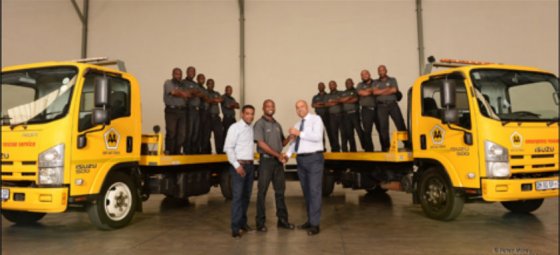
KEYS TO A NEW FUTURE … Mr Sikkie Kajee, Chairman of the Automobile Association (right), and Mr Noelan Vandayar: Executive Operations and Strategy (left), handing over the keys of a towing vehicle to Mr Simon Ngwenya, one of the 60 drivers who will benefit from the Automobile Association’s new empowerment development programme which went live on 1 September. (Picture Credit: Supplied, Automobile Association)
In its ongoing efforts to contribute to the transformation of South African business and industry, the Automobile Association (AA) has introduced an enterprise development programme for the empowerment of its towing drivers. This is in response to the continued barriers of entry that prevent previously and currently disadvantaged new entrants to the towing industry, especially in the more lucrative urban centres.
The programme, which launched yesterday, 1 September, will empower 60 drivers around South Africa to become business owners with the assistance of the AA. This is one the largest empowerment deals within the towing and recovery industries to date. The South African Transport and Allied Workers Union (SATAWU) has been a part of the process since it began and has endorsed the programme.
“The programme will reach a large base of drivers who will, effectively, work for themselves. We will provide them with our existing vehicles through a generous interest-free repayment scheme over 36 months, and support them in a range of aspects including business management, administrative support, working capital, and other services, to ensure a smooth transition to business ownership and first-generation entrepreneurship,” says Noelan Vandayar, Executive: Operations and Strategy at the AA.
He says early feedback from the rural drivers who have embraced this programme, and the initial indications on its progress, are that it is proving to be successful. This part of the programme was launched in June.
“The drivers are certainly aware that the more they do, the more they earn,” explains Vandayar.
Vandayar says the implementation of the programme is an important development in towing in South Africa. He notes that through the programme the AA is investing in the future of businesses which would otherwise have struggled to secure finance and gain a foothold in this competitive industry.
From a customer perspective the trucks will remain AA branded. AA members and corporate customers will still receive the same seamless service.
“These drivers will be working with the AA, not for the AA, and will still be dispatched through our dispatch and monitoring centre based in Midrand. The technology we use is state-of-the-art and our customers will still be able to track the vehicle’s movements through the AA app when they request assistance,” says Vandayar.
He says the drivers have worked for the AA for many years and understand the company and its principles clearly, ensuring continued quality service to customers.
“We are more than comfortable that they will be excellent custodians of our good name with our client base being in tune with our ethos and values, and that is really key to making this programme a success,” he adds.
Vandayar emphasises that the current restructuring of the towing model within the AA will have no impact on the roadside assistance and patrol vehicles which will continue to operate normally as part of the Association going forward.
“This is a good business decision with benefits for the AA and our drivers. We believe offering these drivers the opportunity to own and manage their own businesses, will have a massive positive impact on their lives and the industry,” Vandayar concludes.